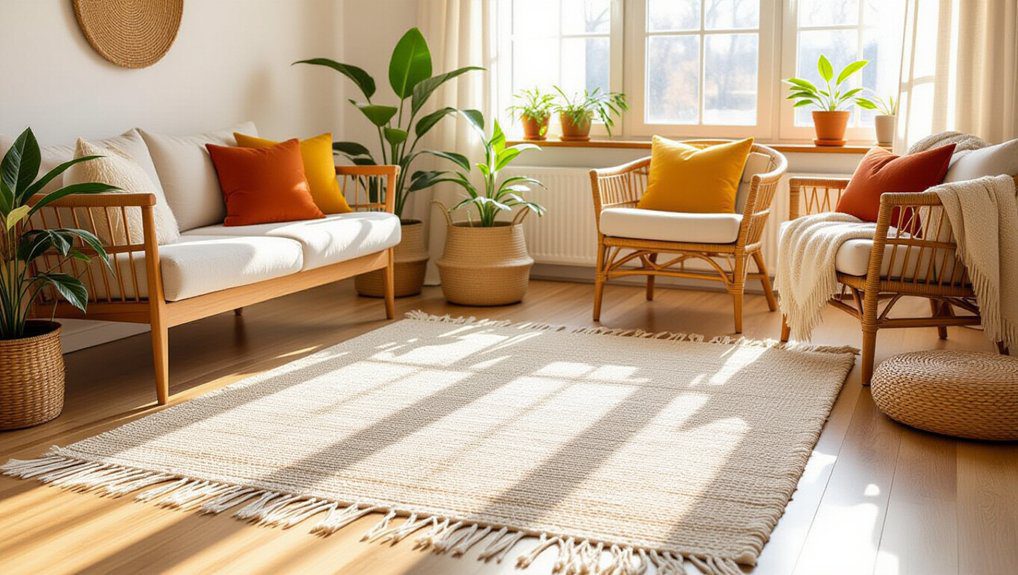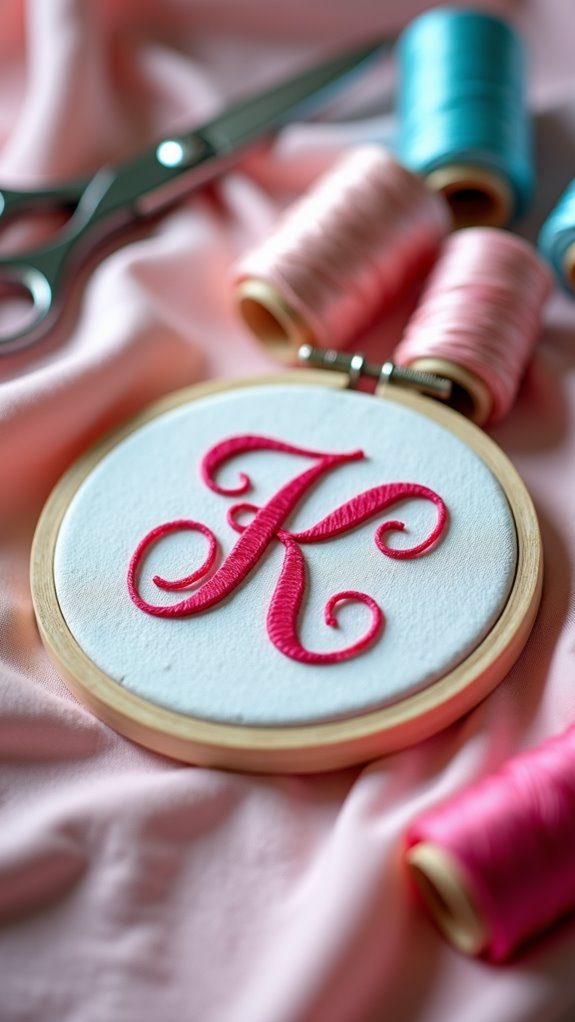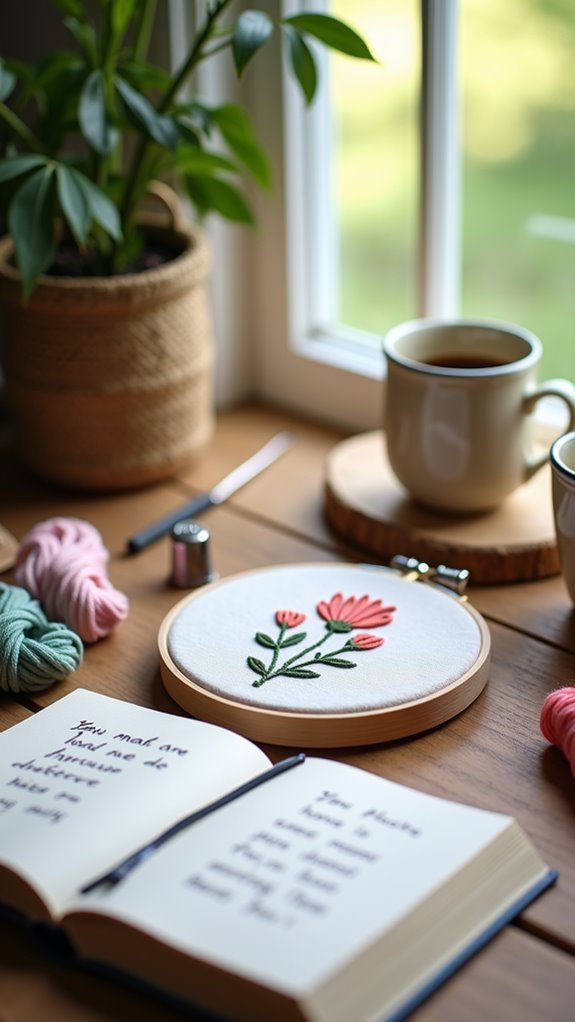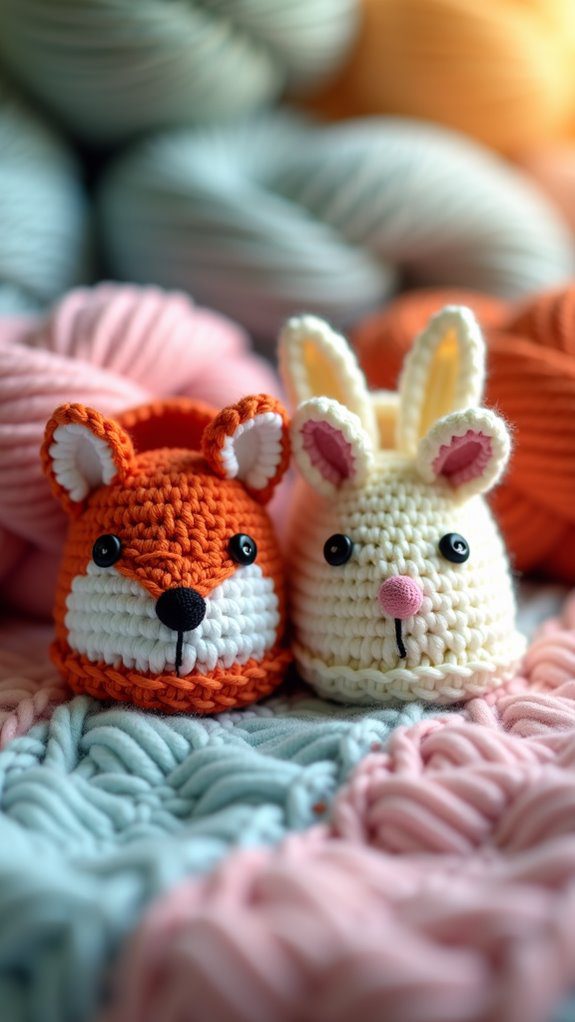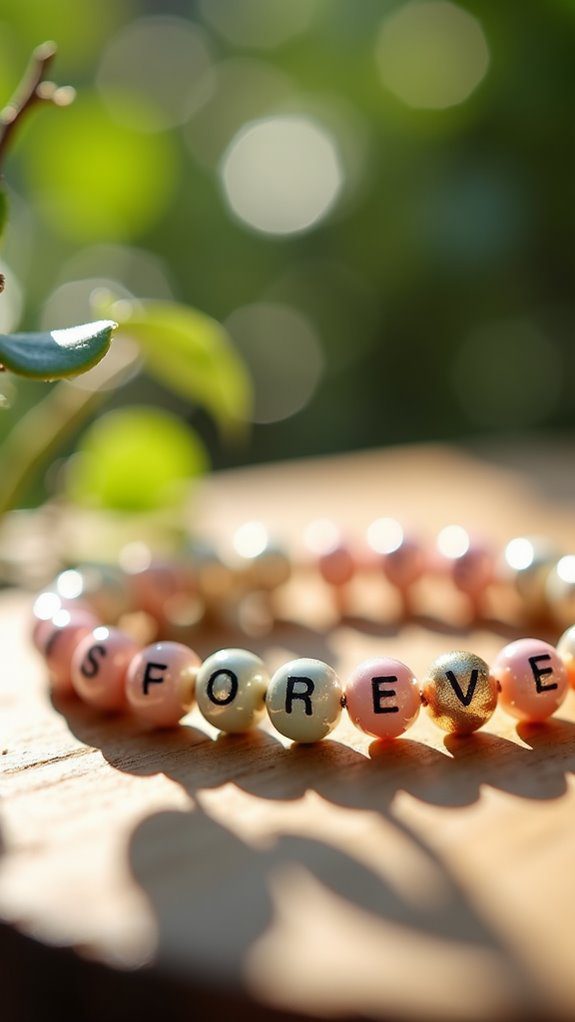I’ve found some fun and easy DIY rug ideas you can make at home, like braided or finger crochet t-shirt rugs that recycle old shirts into cozy floor mats. You can try weaving strips around a hula hoop or create a durable denim rag rug by cutting jeans into strips and sewing them together. For something unique, cut and glue sweater pieces or even paint outdoor astroturf. If you want a plush feel, try a shaggy crochet or a tufting gun technique—you’ll pick up great tips as you investigate these creative projects!
Key Takeaways
- Create braided or finger crochet rugs using old t-shirts cut into strips for eco-friendly, cozy floor coverings.
- Weave fabric strips on a hula hoop or repurpose denim for durable, textured rugs with unique charm.
- Craft yarn pom-pom or latch hook rugs for colorful, plush textures that brighten any room.
- Use sweater pieces or fabric twine sewn or glued for warm, personalized rugs with a lived-in look.
- Try practical options like painted astroturf or vinyl rugs for durable, easy-to-clean indoor and outdoor use.
Braided T-Shirt Rag Rug
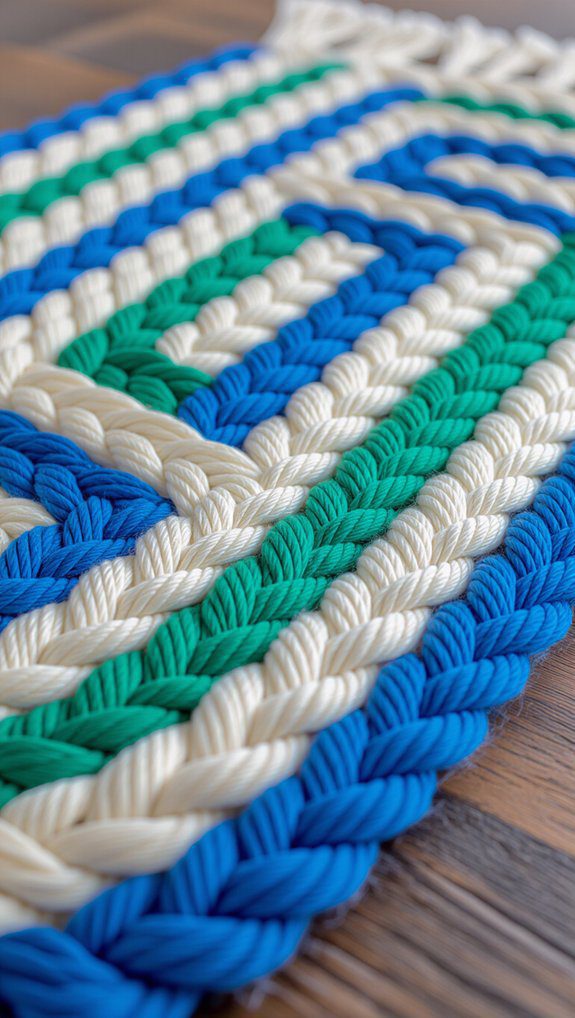
If you’ve ever looked at old t-shirts and wondered what to do with them, making a braided t-shirt rag rug is a fantastic way to give those worn-out shirts a new life.
Using the braided technique benefits both your creativity and the planet by turning fabric scraps into cozy, colorful rugs. Cut t-shirts into 2-3 inch strips, braid them in sections, then sew or tie these braids into your desired shape.
This project is a perfect example of eco friendly crafts—it’s sustainable, customizable, and the rugs get softer with every wash. It’s a fun way to belong to a crafty, green community!
Finger Crochet T-Shirt Rug

One of the easiest and most satisfying ways to transform old t-shirts into something beautiful is by making a finger crochet t-shirt rug. This eco friendly crafting method uses simple t shirt rug techniques that anyone can master, no hook needed—just your fingers! Cutting strips about 1-2 inches wide gives your rug a cozy, textured feel. Plus, you can customize size and colors to match your space perfectly.
| Step | Tip |
|---|---|
| Cut strips | 1-2 inches wide |
| Start loops | Use fingers, not hooks |
| Crochet rows | Keep an even tension |
| Customize | Play with colors |
| Finish rug | Secure ends tightly |
Weaved Hula Hoop Rug
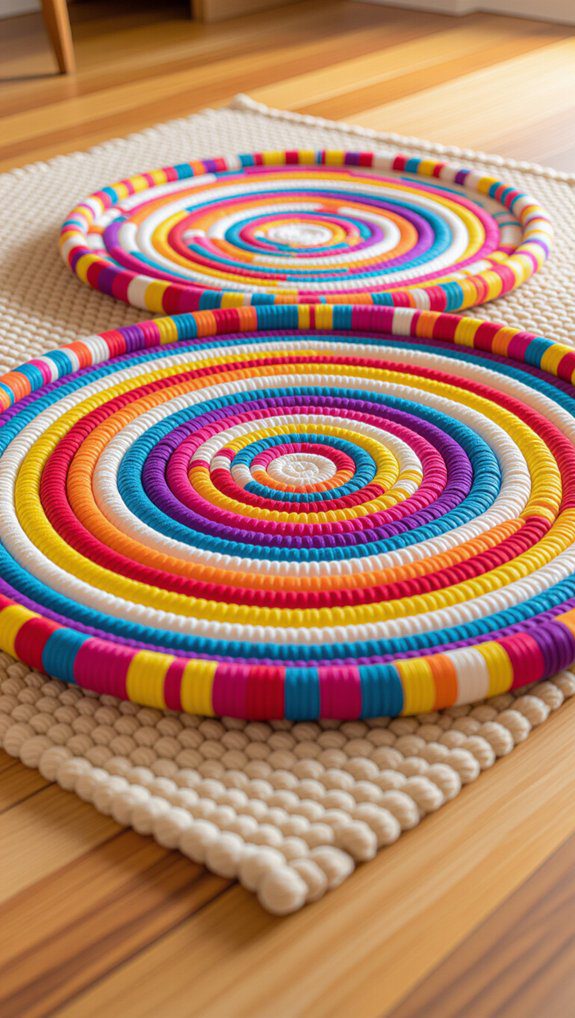
Anyone looking for a quick and creative project will love making a weaved hula hoop rug. Start by gathering hula hoop materials—choose a hoop size that fits your space and fabric strips about 1 to 2 inches wide.
I used leftover fabric, which made the rug design both eco-friendly and unique. Wrap the strips around the hoop, weaving them tightly to create a comfy texture.
Beginners will find this project doable in just a few hours. To finish, secure the edges with fabric glue or stitching so your rug stays durable and cozy for years to come.
Denim Rag Rug
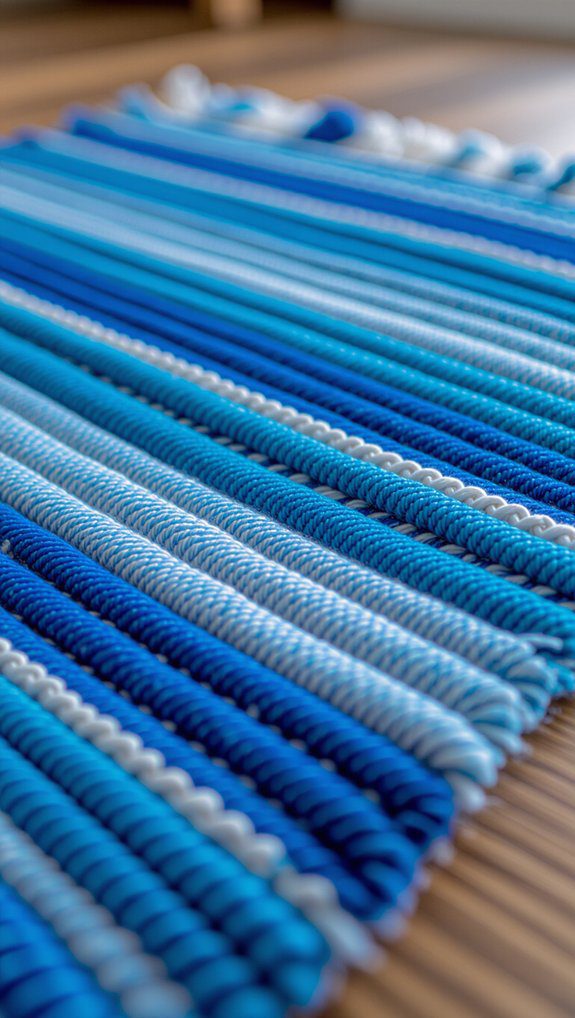
Denim rag rugs bring a wonderful mix of durability and charm to any room, especially when you make them from old jeans or leftover denim fabric.
I love using denim color variations to give my rug a unique, textured look. Cut your denim into two-and-a-half-inch strips with clean edges for easier sewing, and try the chenille technique to add some fun texture.
Use a matching thread and a quarter-inch foot for neat stitches. Once sewn, wash the rug to fray edges softly—that’s a key rug maintenance tip that keeps it cozy and inviting over time.
Cut and Glue Sweater Rug
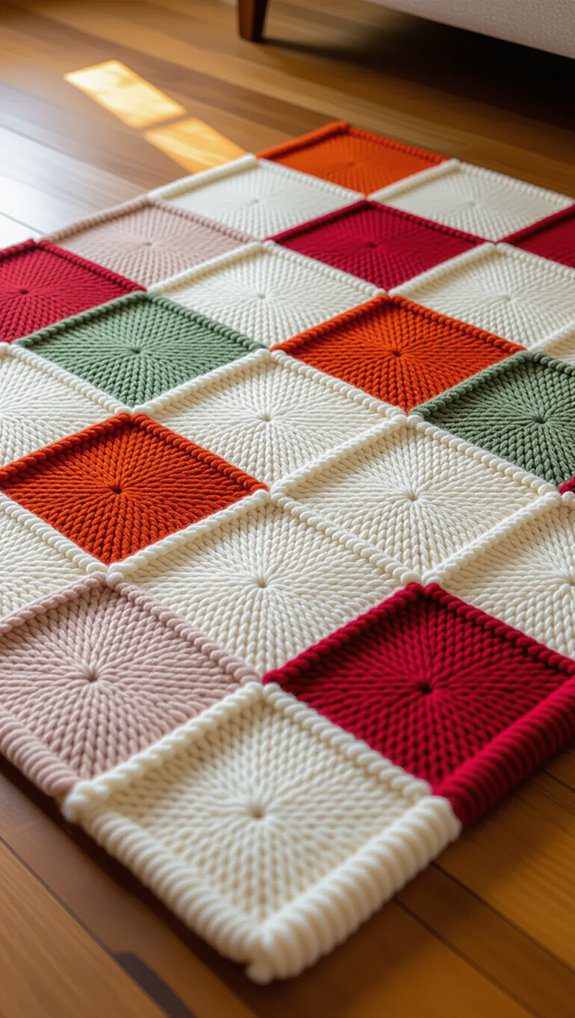
When you want to create a cozy rug with a personal touch, cutting and gluing old sweaters is a fantastic way to do it. First, focus on sweater selection—mix textures and colors for a warm, inviting look. Next, try adhesive options like strong fabric glue that holds up well. Arrange sweater pieces on your backing before gluing to perfect your design. Here’s a quick guide:
| Step | Tip | Result |
|---|---|---|
| Sweater Selection | Choose diverse textures | Unique, cozy feel |
| Cutting | Cut into strips or shapes | Easy to arrange |
| Adhesive Options | Use strong fabric glue | Durable and washable |
| Layout | Arrange before gluing | Perfect color blend |
| Final Touch | Press firmly | Long-lasting rug |
Fabric Twine Spiral Rug

If you enjoyed crafting a cozy rug from old sweaters, you’ll love making a fabric twine spiral rug next.
Start by choosing strips about two and a half inches wide—woven or batik fabrics work best for texture and a charming curl.
The key is in the sewing techniques: coil the strips tightly, sewing as you go with consistent tension to avoid puckers.
After sewing, wash your rug to fray the edges slightly, giving it a warm, lived-in look.
Using leftover fabric makes this project affordable and personal, perfect for adding a unique touch to your space.
Yarn Pom-Pom Rug
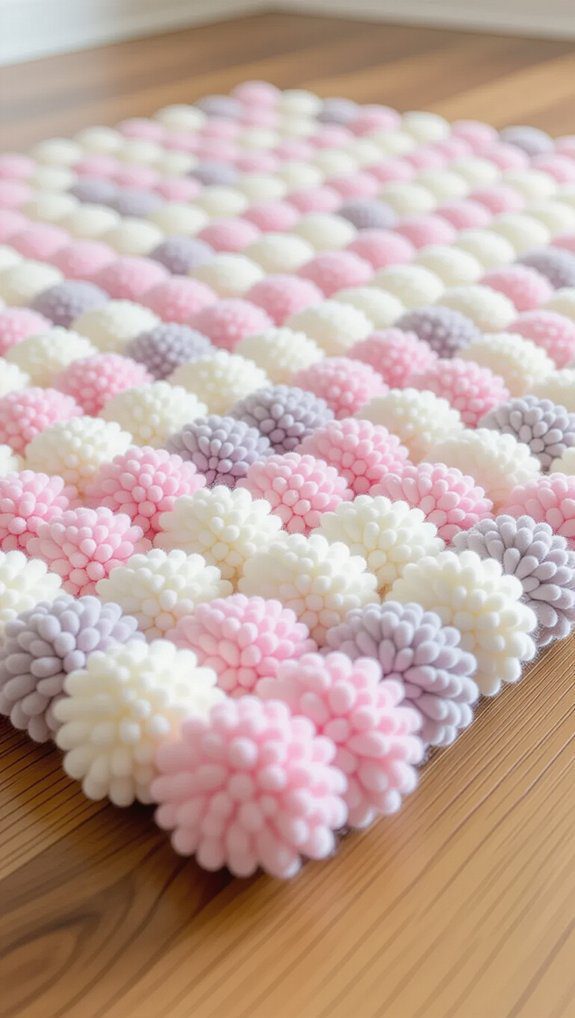
Creating a yarn pom-pom rug is a fun and colorful way to brighten up any room, and you don’t need to be an expert crafter to get started.
First, gather yarn in your favorite color combinations and choose pom pom techniques that suit your style, like using a pom-pom maker or cardboard templates.
Make pom-poms in various sizes, then attach them securely to a sturdy fabric base using glue or sewing.
This rug adds soft texture and cozy charm, perfect for sharing a warm, inviting space with friends or family while showcasing your creative touch.
Cotton Piping Shag Rug
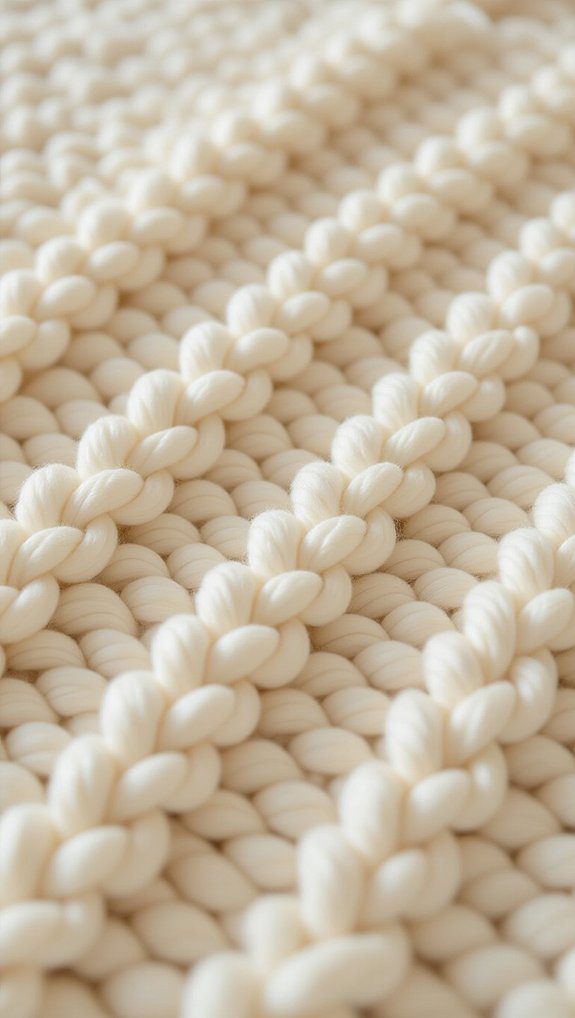
A cotton piping shag rug brings a cozy, textured vibe to any space, and making one yourself is easier than you might think.
Start with cotton fabric selection—choose durable strips in colors and patterns you love. Next, cut uniform strips using a shape cut ruler.
Then, apply rug backing techniques by sewing the strips onto a sturdy backing fabric for structure. Finally, wash the rug regularly to fray edges and boost texture.
This project not only adds warmth but also invites a personal touch to your home, making it feel truly yours and welcoming to all who enter.
Heart-Shaped Leopard Rug
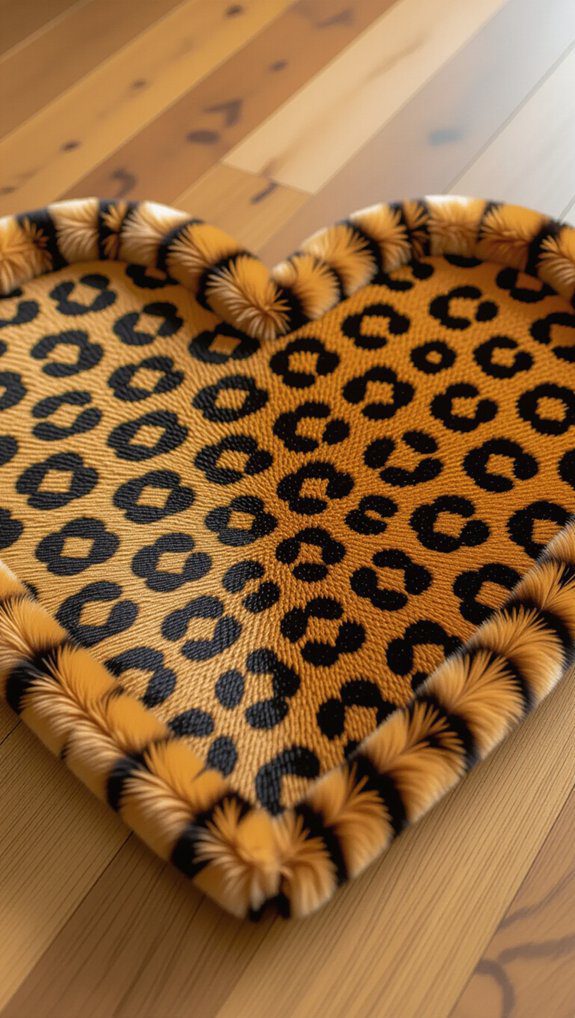
Although it might sound tricky at first, making a heart-shaped leopard rug is a fun way to turn leftover fabric strips into a charming, cozy piece for your room. Start by drawing a heart shape on your backing fabric, then cut 2.5-inch strips for a neat leopard design. I love using batik fabrics for texture, but solids work too! Sew strips with a chenille technique and wash the rug to reveal that fluffy, burst-thread look. Here’s a quick guide:
| Step | Tip |
|---|---|
| Draw Heart | Use fabric chalk |
| Cut Strips | Consistent 2.5 inches |
| Sew Together | Chenille stitch for texture |
| Wash & Fluff | Improves leopard design |
This heart rug adds warmth and style, making your space feel uniquely yours!
DIY Anthropologie Rug

When you want to add a cozy, stylish touch to your room without spending a fortune, making a DIY Anthropologie-inspired rug is a fantastic project to try.
Start with fabric selection—leftover woven strips work best for texture and durability. Here’s a quick guide:
- Cut consistent 2.5-inch strips using a shape cut ruler.
- Sew strips together with a quarter-inch foot and matching thread for neat seams.
- Aim for a 36×40 inch rug, using about nine yards of fabric.
- Turn the backing right side out and wash to create that textured, burst-thread look.
You’ll love how welcoming it feels!
Denim Waistband Rug

If you enjoyed crafting that cozy Anthropologie-inspired rug, you’ll love exploring how to make a denim waistband rug next. I use old jeans’ waistbands for durability and texture, cutting consistent two-and-a-half-inch strips. Sewing them with a quarter-inch foot creates a neat finish. Once sewn, I gently cut the top layer to fray edges, adding charm. Washing fluffs these fringes, enhancing softness. Here’s a quick guide:
| Step | Tip |
|---|---|
| Cut strips | Use varied denim colors |
| Sew strips | Keep seams tight |
| Fray edges | Cut gently for texture |
| Maintenance | Wash to fluff and soften rug |
This rug feels like a cozy, personal treasure.
Thrifted Bath Mat Rug
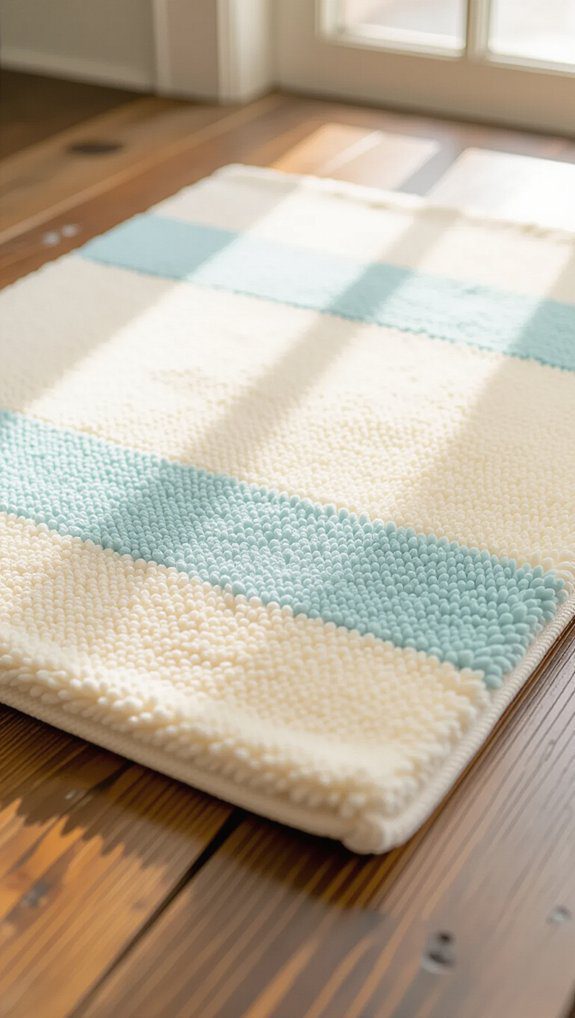
Transforming thrifted bath mats into a layered rug brings a fun and creative twist to your bathroom decor that you’ll really enjoy.
I love hunting for thrift store finds like cotton bath mats—they’re soft, absorbent, and perfect for this project.
Here’s how to start:
- Pick mats with different colors or patterns for a lively look.
- Layer them to create texture and depth.
- Sew or glue edges securely to avoid slipping.
- Place your new rug proudly in your bathroom for instant charm.
This eco-friendly idea adds personality while reusing materials you love!
Latch Hook Rug

A latch hook rug offers a fun and creative way to add a cozy touch to any room, and I’m excited to guide you through this crafty project.
Using latch hook techniques, you pull yarn or fabric strips through a canvas grid, knotting them to create a plush, textured surface.
Latch hook patterns help you design anything from small mats to large area rugs, making this project perfect for beginners and pros alike.
Grab a kit or gather acrylic yarn and a sturdy canvas, then follow the simple steps to craft a personalized rug that feels like home.
Boho Pom-Pom Rug

Latch hook rugs are great for creating cozy textures, but if you’re looking to add a playful, bohemian vibe to your space, making a Boho pom-pom rug is a fantastic next project.
I love mixing color combinations and experimenting with pom pom sizes to make each rug unique. Here’s how I do it:
- Wrap yarn around cardboard to create pom-poms.
- Choose pom-pom sizes—larger for bold, smaller for delicate looks.
- Attach pom-poms evenly onto a sturdy backing using glue or sewing.
- Use leftover yarn for an eco-friendly touch.
It’s fun and welcoming to craft together!
Mod Podge Fabric Rug
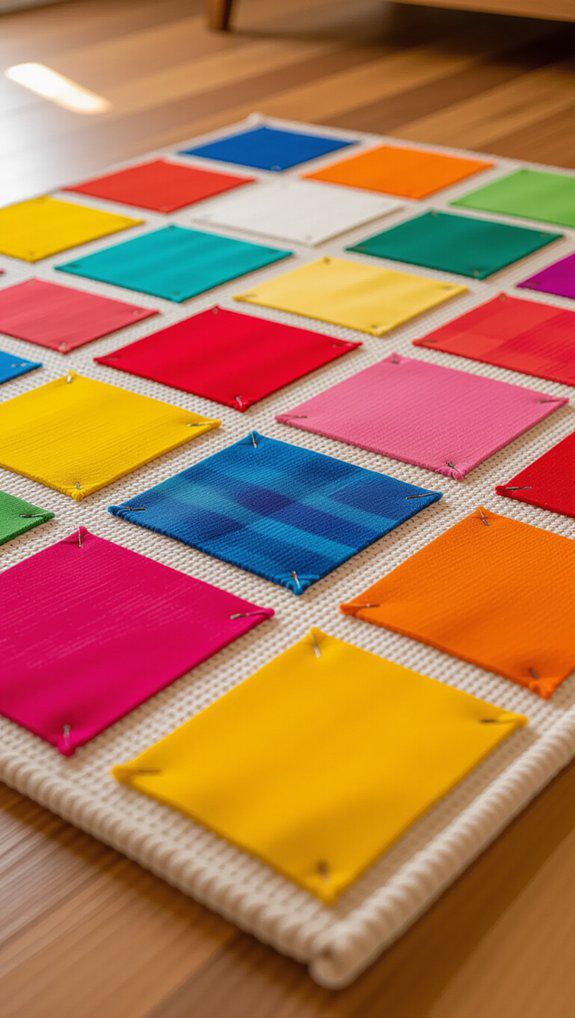
One of the simplest ways to create a personalized rug is by using Mod Podge to attach fabric strips to a sturdy backing, and I’m excited to show you how fun and rewarding this project can be.
Start by choosing fabric choices that reflect your style, then cut them into strips.
Apply Mod Podge to the backing, press fabric down smoothly, and use sealing techniques by layering Mod Podge on top to protect your work.
Trim edges neatly to prevent fraying, and let it dry for 24 hours.
This method lets you craft a cozy rug that feels truly yours.
Canvas Drop Cloth Rug

Canvas drop cloths make fantastic materials for DIY rugs because they’re both affordable and tough enough to handle daily use.
I love how easy canvas customization lets me create a rug that fits my space perfectly. Here’s how I approached mine:
- Cut the drop cloth into strips or shapes I liked.
- Painted simple designs for a personal touch.
- Sewed the pieces together for sturdiness.
- Followed easy drop cloth maintenance tips to keep it fresh.
This project not only brightened my home but also made me feel part of a creative community, crafting something truly mine.
Sponge Painted Rug
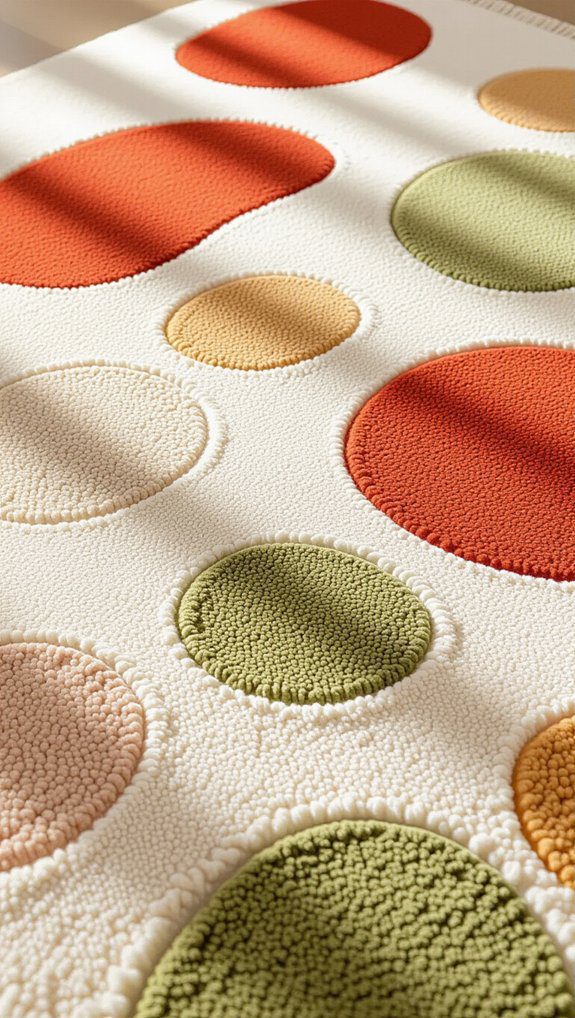
After enjoying the hands-on fun of customizing a canvas drop cloth rug, you’ll find sponge painting offers another exciting way to add personality to your floors.
Start with a plain, light-colored rug and choose the right fabric paint selection to keep colors vibrant and durable. Using natural or synthetic sponges, dab paint in various hues and patterns to create texture.
Try sponge painting techniques like layering colors or using stencils for geometric designs. Let your rug dry completely, then heat set it following the paint instructions to guarantee long-lasting beauty.
It’s a creative project that truly invites your unique touch.
Felt Recycled Sweater Rug
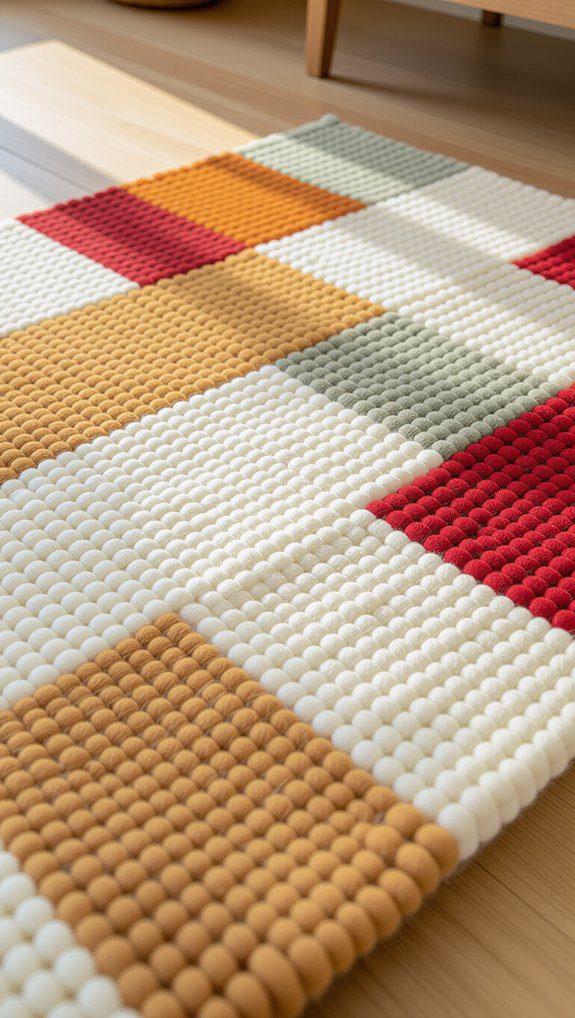
When you want a rug that feels cozy and looks unique, making a felt recycled sweater rug is a fantastic choice.
Start with sweater selection—pick ones with colors and textures that blend well.
Then, follow these steps:
- Felt the sweaters by washing them hot and drying on high heat for better rug durability.
- Cut sweaters into strips or squares.
- Sew or tie pieces together to form your rug.
- Customize size and design to fit your space perfectly.
This eco-friendly project creates a warm, durable rug that invites comfort and belonging into your home.
Fabric Kitchen Rug
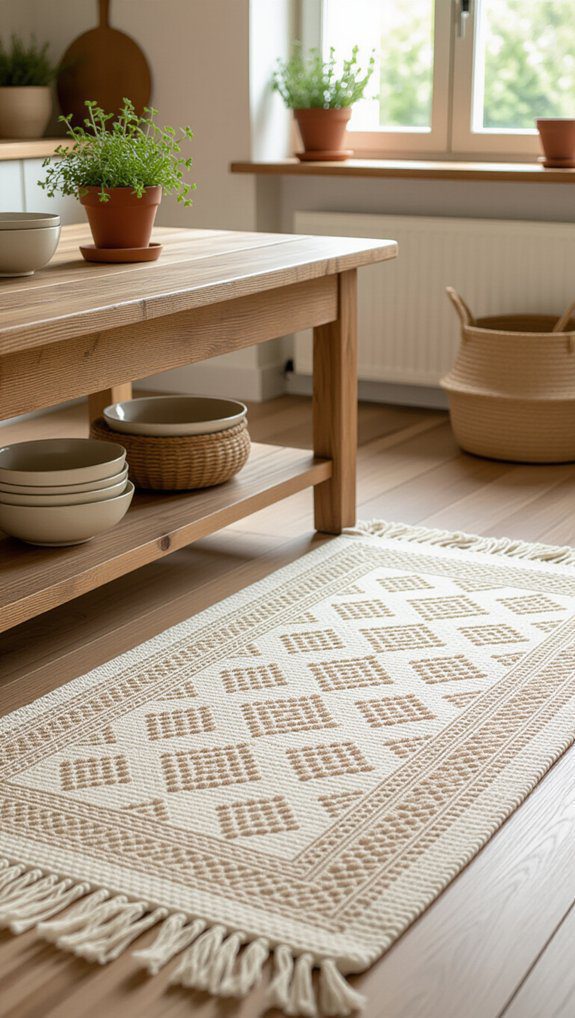
Creating a fabric kitchen rug offers a wonderful way to bring color and comfort into one of the busiest spots in your home. Using fabric color combinations like woven solids and batiks adds charm and texture, while rug size variations let you customize fit perfectly. I cut leftover fabric strips, about two and a half inches wide, sew them on backing with matched thread, then wash for a cozy, textured finish. Here’s a quick look:
| Fabric Type | Color Combo | Rug Size |
|---|---|---|
| Woven | Bold & Soft | 24×36 inches |
| Batik | Earth Tones | 36×40 inches |
| Mixed | Bright Mix | Custom sizes |
Custom Vinyl Flooring Rug

Vinyl flooring rugs offer a fantastic way to add personality and practicality to any room without much hassle.
I love creating custom vinyl rugs because you can pick vinyl patterns that match your style perfectly.
Here’s how I make mine:
- Choose vinyl sheets in colors and patterns you love.
- Cut the vinyl to fit your space using a utility knife.
- Add a non-slip backing to keep it safe.
- For easy rug maintenance, just wipe down with a damp cloth.
These rugs stay durable and fresh-looking, making your space feel truly yours!
Hopscotch Game Rug
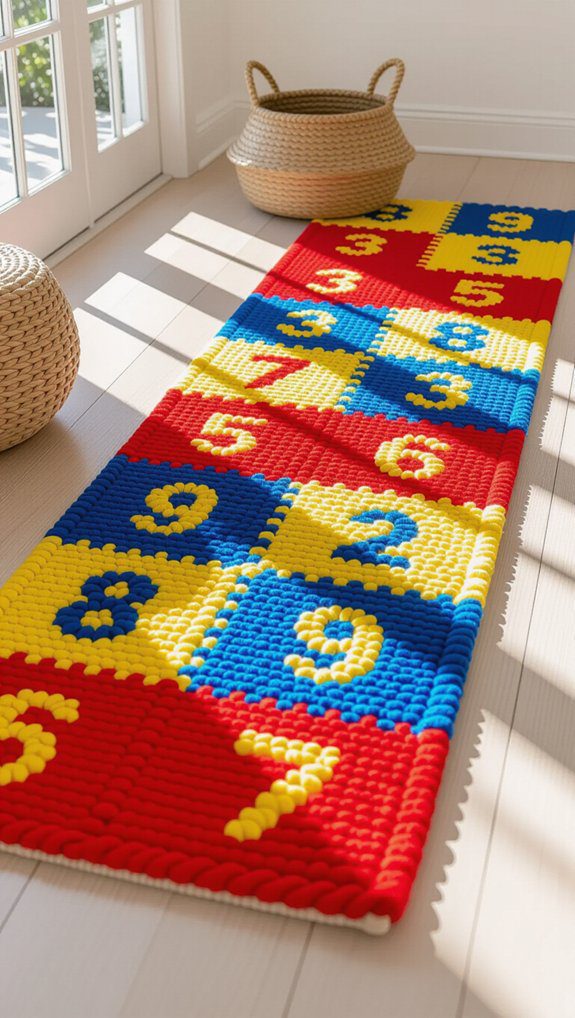
Adding a playful touch to your space doesn’t have to stop with custom vinyl rugs—I’ve found that making a hopscotch game rug is a fantastic way to bring fun and function together.
Start by choosing fabric choices with contrasting colors and hopscotch patterns to catch the eye and spark excitement. Using leftover fabric strips and a simple chenille technique, you can customize the rug’s size to fit your play area perfectly.
I recommend about three jelly rolls for a 36×40-inch rug. After sewing and washing, the textured, burst-thread look makes it inviting and ready for endless hopscotch fun.
Plywood Office Rug

Even though plywood mightn’t be the first material that comes to mind when you think of rugs, it actually makes for a surprisingly stylish and practical office floor covering.
I love how plywood durability means it lasts, giving your workspace a unique touch.
Here’s how you can create your own plywood office rug:
- Cut plywood to your preferred size and shape.
- Paint or stain it to match your decor.
- Add non-slip backing or felt pads underneath to protect floors.
- Customize designs using stencils or decals for personality.
This project feels like belonging—your space, your style!
Patchwork Remnant Rug
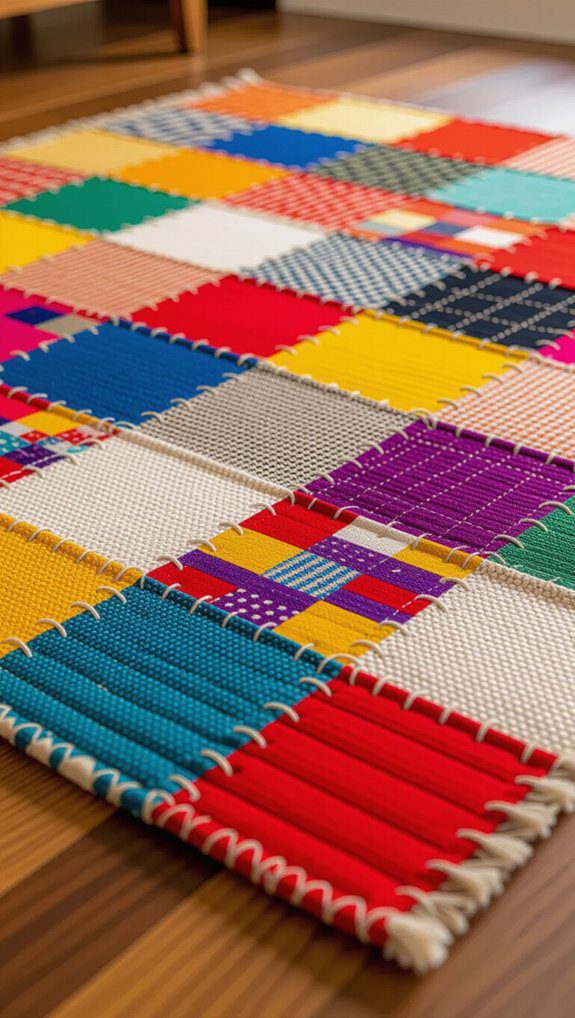
While it might seem tricky at first, making a patchwork leftover rug is a fantastic way to turn leftover fabric strips into a cozy, colorful floor covering that’s both budget-friendly and charming.
Start by cutting fabric strips into uniform two-and-a-half-inch widths; this helps with neat fabric color combinations. Use the chenille rug texture techniques by sewing layers on a marked backing fabric, guided by lines and a quarter-inch foot for even stitches.
After sewing, washing the rug creates a soft, textured finish and removes loose threads, giving you a warm, personal rug that welcomes everyone into your space.
Painted Astroturf Rug

If you want a rug that’s tough enough to handle rain, sun, and all kinds of outdoor fun, a painted Astroturf rug is a fantastic choice.
It’s perfect for boosting your outdoor aesthetics with unique painted designs.
Here’s how I do it:
- Clean the Astroturf thoroughly to remove dirt.
- Choose outdoor spray or fabric paint made for synthetic materials.
- Apply multiple coats, letting each dry for vibrant colors.
- Place it on your patio or deck to enjoy a weather-resistant, personalized rug.
This DIY project truly makes your space feel like home.
Potholder Rug

Moving from a sturdy outdoor rug like the painted Astroturf, let’s bring some cozy charm indoors with a potholder rug.
Using leftover fabric strips—around two and a half inches wide—makes this project eco-friendly and wallet-friendly. For fabric selection advice, mix textures and colors to add visual interest and warmth.
Potholder design tips? Keep your quarter-inch seams consistent for a neat finish, and don’t be afraid to experiment with shapes and sizes.
After sewing your strips to a backing fabric, wash the rug to soften it and let those frayed edges create a charming, lived-in look you’ll love.
Rug Tufting Gun Method
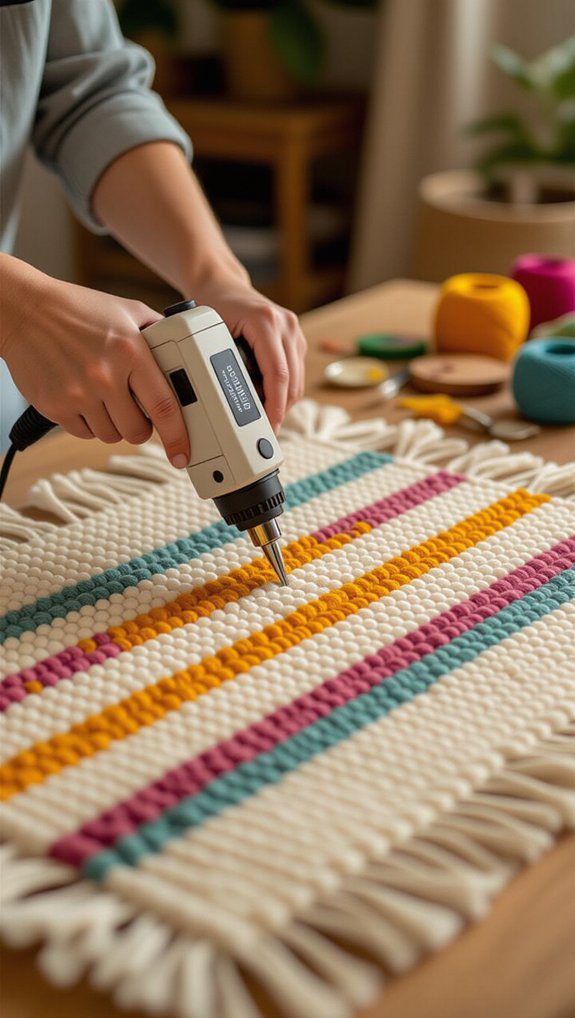
A rug tufting gun is a fantastic tool that makes creating your own custom rugs both fast and fun.
Using this method, you can investigate fantastic tufting techniques to craft unique textures. Here’s how I get started:
- Choose a sturdy backing like monk’s cloth.
- Pick colorful yarns to bring your design alive.
- Always wear protective eyewear and keep fingers clear—safety precautions matter!
- After tufting, add a latex backing for durability.
This method really brings us together as creators, making rug-making accessible and exciting for everyone willing to try!
Shaggy Crochet Rug
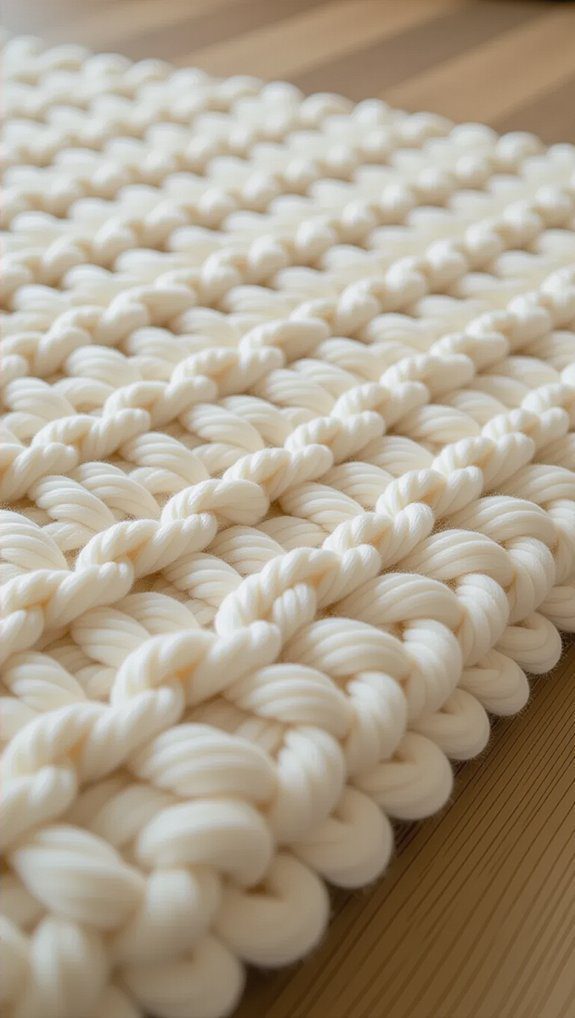
Everyone loves the cozy charm a shaggy crochet rug brings to a room, and I’m excited to show you how to create one yourself.
Start by choosing yarns with different textures and thicknesses—chunky or textured fibers add that irresistible shaggy texture we’re after.
Use basic stitches like single or double crochet, adjusting your hook size or stitch tension to leave longer yarn strands untrimmed. This gives the rug its plush, shaggy look.
Remember, your yarn choices impact both feel and appearance, so pick colors and fibers that make you smile.
Finish by weaving in ends and trimming strands evenly.


